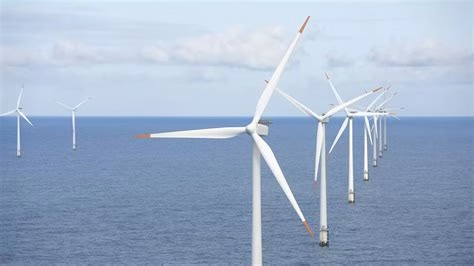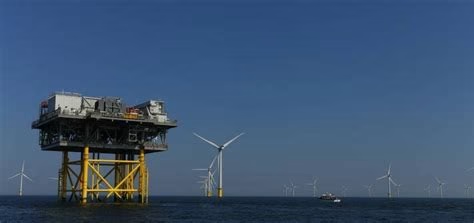TenneT has completed and fully energized the 900 MW DolWin5 HVDC grid link system in Germany’s North Sea. The transmission operator confirmed the development in October 2025, marking a crucial step toward bringing Ørsted’s Borkum Riffgrund 3 offshore wind farm online. Borkum is one of the largest offshore projects under development in German waters.
TenneT DolWin5 HVDC Link
The DolWin5 high-voltage direct current (HVDC) link, operated by TenneT, will now provide an export route for power generated from Borkum Riffgrund 3 to the German mainland. The offshore converter platform, DolWin epsilon, and its corresponding onshore station will transmit nearly one gigawatt of renewable electricity over a distance of around 100 kilometers.
With the energization complete, Ørsted and its partners can now begin final testing and commissioning activities at Borkum Riffgrund 3, positioning the project to start operations in 2026.
The development also underscores the growing collaboration between grid operators and wind developers in integrating new generation capacity into Europe’s offshore network. It also points toward the strengthening of supply reliability as Germany transitions away from fossil fuels.
Factsheet for TenneT DolWin5 HVDC Link and Borkum Riffgrund 3 Wind Farm
Grid Operator: TenneT TSO GmbH
Wind Farm Developer: Ørsted
Partner: Glennmont Partners
DolWin5 Capacity: 900 MW HVDC transmission link
Borkum Riffgrund 3 Capacity: 913 MW offshore wind farm
Technology: Siemens Energy HVDC system
Offshore Platform: DolWin epsilon
Location: German North Sea, 110 km off Lower Saxony coast
Power Transmission Distance: 100 km
Power Supply Equivalent: 900,000 homes

Timeline
2019: Ørsted awarded rights to develop Borkum Riffgrund 3
2020: TenneT awards Siemens Energy the DolWin5 HVDC contract
2022: Construction of DolWin epsilon platform and cable installation begins
2024: Offshore substation and platform installed. Turbine installation also advances
October 2025: DolWin5 system fully energized
2026: Borkum Riffgrund 3 expected to begin full commercial operation
Impact to the Region and Germany’s Renewable Energy Landscape
The DolWin5-Borkum Riffgrund 3 connection represents an important component of Germany’s broader North Sea energy corridor, where grid infrastructure and offshore generation are increasingly being developed in tandem.
The project also supports Germany’s plan to install at least 30 GW of offshore wind capacity by 2030. This target scales up to 70 GW by 2045 under the country’s long-term climate strategy.
TenneT’s energization of DolWin5 also reflects the operator’s growing portfolio of HVDC offshore grid systems. The company now collectively links more than 9 GW of offshore capacity to the mainland. It also reinforces Germany’s role as a core hub in the North Sea power network, connecting with emerging interconnector projects toward Denmark, the Netherlands, and future North Sea energy islands.
For Ørsted, the Borkum Riffgrund 3 wind farm adds nearly a gigawatt of zero-carbon capacity to its German fleet. The Danish energy company portfolio includes Gode Wind 1 and 2 and Borkum Riffgrund 1 and 2. The project will also be Ørsted’s largest offshore installation in Germany, built without state subsidies. This highlights both the maturity of Europe’s offshore wind market and the competitiveness of large-scale renewable investments in a post-subsidy environment.
The combined infrastructure also strengthens grid reliability in northern Germany. This will enable smoother integration of intermittent wind power into the transmission system.
Analysts also note that projects like DolWin5 are paving the way for a next generation of coordinated offshore hubs. These will be capable of serving multiple wind farms and countries, advancing Europe’s shared energy transition goals.

